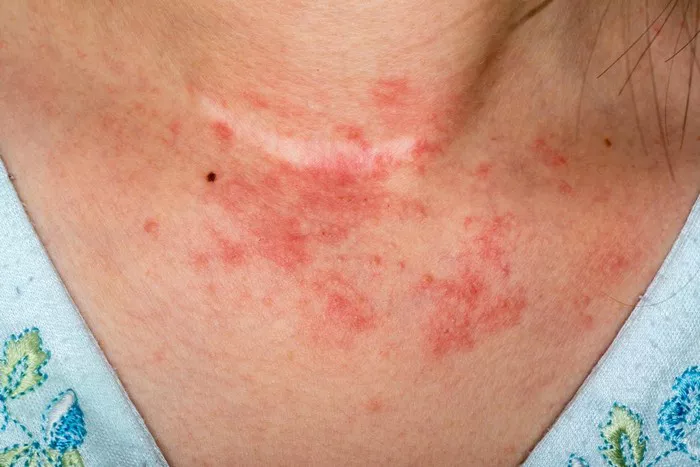Contact dermatitis is a common skin condition characterized by inflammation resulting from contact with irritants or allergens. It manifests as red, itchy, and sometimes blistered skin, causing discomfort and distress to those affected. This article explores the various types, causes, symptoms, diagnosis, and treatment options available for contact dermatitis, empowering readers with knowledge to manage and alleviate this troublesome skin condition effectively.
Types of Contact Dermatitis
Contact dermatitis is broadly categorized into two main types: irritant contact dermatitis (ICD) and allergic contact dermatitis (ACD).
Irritant Contact Dermatitis (ICD): This type of dermatitis occurs when the skin comes into direct contact with a substance that damages the outer layer, triggering an inflammatory response. Common irritants include soaps, detergents, acids, solvents, and even water in excessive amounts. ICD is more prevalent than ACD and can affect anyone exposed to irritants in daily life or specific occupational settings.
Allergic Contact Dermatitis (ACD): ACD results from an allergic reaction to a substance upon repeat exposure. Notable allergens include nickel (often found in jewelry), fragrances, preservatives in cosmetics, rubber, and certain plants like poison ivy. ACD typically requires sensitization—initial exposure primes the immune system, leading to an allergic response upon subsequent contact.
Causes and Risk Factors
Understanding the causes and risk factors associated with contact dermatitis is crucial for prevention and management.
1. Common Causes: Contact dermatitis can be triggered by a wide range of substances, including chemicals, metals, plants, cosmetics, medications, and fabrics. Identifying the specific allergen or irritant responsible is essential for effective treatment.
2. Occupational Exposure: Certain professions carry a higher risk of contact dermatitis due to frequent exposure to irritants or allergens. These include healthcare workers, hairdressers, cleaners, mechanics, and construction workers.
3. Personal Sensitivity: Individuals with a personal or family history of atopic dermatitis, asthma, or allergies are more prone to developing contact dermatitis.
Symptoms and Diagnosis
Recognizing the symptoms of contact dermatitis is the first step towards seeking appropriate treatment.
1. Symptoms: The symptoms of contact dermatitis typically include redness, itching, swelling, and sometimes blistering or oozing of the affected skin. The rash is usually localized to the area of contact with the irritant or allergen.
2. Diagnosis: Diagnosing contact dermatitis involves a thorough evaluation of medical history, occupational exposure, and a physical examination. In some cases, patch testing may be necessary to identify specific allergens responsible for allergic contact dermatitis.
Treatment Options
Treatment for contact dermatitis aims to relieve symptoms, reduce inflammation, and prevent future flare-ups. The approach varies depending on the type and severity of the condition.
1. Avoidance of Triggers: The primary strategy for managing contact dermatitis is to identify and avoid the irritants or allergens responsible for the skin reaction. This may involve changing skincare products, wearing protective gloves, or modifying work practices to minimize exposure.
Topical Treatments:
1. Corticosteroids: These anti-inflammatory creams or ointments are often prescribed to reduce itching and inflammation during flare-ups.
Topical Calcineurin Inhibitors: Non-steroidal medications that can be used to treat eczema and other inflammatory skin conditions.
2. Systemic Treatments: In severe cases of contact dermatitis, oral medications such as corticosteroids or antihistamines may be prescribed to manage symptoms.
3. Wet Dressings: Applying wet compresses or dressings to affected areas can provide relief from itching and help to dry out blisters.
4. Phototherapy: In some cases, controlled exposure to ultraviolet light (UV) under medical supervision can help reduce inflammation and alleviate symptoms.
Preventive Measures
Prevention plays a critical role in managing contact dermatitis and reducing the frequency of flare-ups.
1. Protective Measures: Wear gloves or protective clothing when handling irritants or allergens, especially in occupational settings.
2. Skincare Regimen: Choose hypoallergenic and fragrance-free skincare products to minimize the risk of skin reactions.
3. Avoidance Strategies: Learn to identify and avoid known triggers, such as specific plants, metals, or chemicals.
When to Seek Medical Advice
It’s important to consult a dermatologist or healthcare provider if symptoms persist despite self-care measures or if the condition worsens. Timely intervention can prevent complications and ensure effective management of contact dermatitis.
Conclusion
In conclusion, contact dermatitis is a common skin condition that can significantly impact quality of life. By understanding its causes, symptoms, and treatment options, individuals can take proactive steps to manage and alleviate symptoms effectively. Through proper identification of triggers and adherence to preventive measures, individuals can minimize the impact of contact dermatitis on their daily lives and maintain healthy, comfortable skin. If you suspect contact dermatitis or experience persistent skin issues, seek guidance from a qualified healthcare professional for personalized diagnosis and treatment.
Related Topics:
How Are Eczema and Asthma Related

























